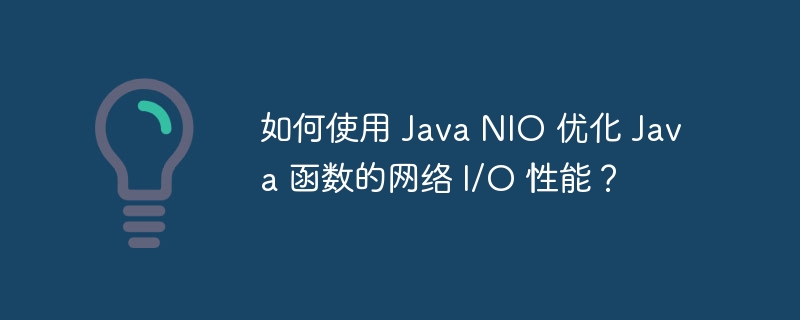How to optimize network I/O performance of Java functions using Java NIO?
Use Java NIO to optimize network I/O performance to significantly increase response speed, throughput and reduce latency. NIO uses a non-blocking I/O method, allowing applications to perform other tasks when I/O operations are not completed. It can also handle multiple connections at the same time to increase data throughput. The NIO chat server in this case demonstrates how to take advantage of NIO to optimize network I/O performance and handle client connections and message broadcasts.

Use Java NIO to optimize the network I/O performance of Java functions
Java NIO (non-blocking I/O) is a A set of Java APIs that can be used to develop high-performance network applications. NIO can significantly improve network performance by allowing applications to perform I/O operations in a non-blocking manner.
Advantages of NIO
- Non-blocking I/O: The application can perform other tasks while the I/O operation is not completed , thereby improving response speed.
- High throughput: NIO allows applications to handle multiple connections simultaneously, thereby increasing data throughput.
- Low latency: Non-blocking operations reduce latency because applications do not need to wait for I/O operations to complete before they can continue execution.
Practical case: NIO chat server
The following is a practical case using NIO to implement a simple chat server:
import java.io.IOException;
import java.net.InetSocketAddress;
import java.nio.ByteBuffer;
import java.nio.channels.SelectionKey;
import java.nio.channels.Selector;
import java.nio.channels.ServerSocketChannel;
import java.nio.channels.SocketChannel;
import java.util.Iterator;
import java.util.Set;
public class NIOChatServer {
public static void main(String[] args) throws IOException {
// 创建 ServerSocketChannel
ServerSocketChannel serverSocketChannel = ServerSocketChannel.open();
serverSocketChannel.bind(new InetSocketAddress(9090));
serverSocketChannel.configureBlocking(false);
// 创建 Selector
Selector selector = Selector.open();
// 将 ServerSocketChannel 注册到 Selector 中
serverSocketChannel.register(selector, SelectionKey.OP_ACCEPT);
while (true) {
// 阻塞选择键
selector.select();
// 获取已就绪的 SelectionKey 集合
Set<SelectionKey> selectionKeys = selector.selectedKeys();
Iterator<SelectionKey> iterator = selectionKeys.iterator();
while (iterator.hasNext()) {
SelectionKey selectionKey = iterator.next();
if (selectionKey.isAcceptable()) {
// 新连接,接受并注册到 Selector 中
SocketChannel socketChannel = serverSocketChannel.accept();
socketChannel.configureBlocking(false);
socketChannel.register(selector, SelectionKey.OP_READ);
} else if (selectionKey.isReadable()) {
// 已收到数据,读取并广播
SocketChannel socketChannel = (SocketChannel) selectionKey.channel();
ByteBuffer buffer = ByteBuffer.allocate(1024);
int read = socketChannel.read(buffer);
if (read > 0) {
String message = new String(buffer.array(), 0, read);
broadcast(selector, socketChannel, message);
}
}
// 移除处理过的 SelectionKey
iterator.remove();
}
}
}
public static void broadcast(Selector selector, SocketChannel sourceChannel, String message)
throws IOException {
// 获取 Selector 中所有的已注册 Channel
Set<SelectionKey> selectionKeys = selector.keys();
for (SelectionKey selectionKey : selectionKeys) {
// 排除源 Channel
if (selectionKey.channel() instanceof SocketChannel
&& selectionKey.channel() != sourceChannel) {
SocketChannel socketChannel = (SocketChannel) selectionKey.channel();
ByteBuffer buffer = ByteBuffer.wrap(message.getBytes());
socketChannel.write(buffer);
}
}
}
}This server uses NIO handles client connections and message broadcasts, demonstrating how to take advantage of NIO to optimize network I/O performance.
The above is the detailed content of How to optimize network I/O performance of Java functions using Java NIO?. For more information, please follow other related articles on the PHP Chinese website!

Hot AI Tools

Undresser.AI Undress
AI-powered app for creating realistic nude photos

AI Clothes Remover
Online AI tool for removing clothes from photos.

Undress AI Tool
Undress images for free

Clothoff.io
AI clothes remover

AI Hentai Generator
Generate AI Hentai for free.

Hot Article

Hot Tools

Notepad++7.3.1
Easy-to-use and free code editor

SublimeText3 Chinese version
Chinese version, very easy to use

Zend Studio 13.0.1
Powerful PHP integrated development environment

Dreamweaver CS6
Visual web development tools

SublimeText3 Mac version
God-level code editing software (SublimeText3)

Hot Topics
 Square Root in Java
Aug 30, 2024 pm 04:26 PM
Square Root in Java
Aug 30, 2024 pm 04:26 PM
Guide to Square Root in Java. Here we discuss how Square Root works in Java with example and its code implementation respectively.
 Perfect Number in Java
Aug 30, 2024 pm 04:28 PM
Perfect Number in Java
Aug 30, 2024 pm 04:28 PM
Guide to Perfect Number in Java. Here we discuss the Definition, How to check Perfect number in Java?, examples with code implementation.
 Random Number Generator in Java
Aug 30, 2024 pm 04:27 PM
Random Number Generator in Java
Aug 30, 2024 pm 04:27 PM
Guide to Random Number Generator in Java. Here we discuss Functions in Java with examples and two different Generators with ther examples.
 Weka in Java
Aug 30, 2024 pm 04:28 PM
Weka in Java
Aug 30, 2024 pm 04:28 PM
Guide to Weka in Java. Here we discuss the Introduction, how to use weka java, the type of platform, and advantages with examples.
 Armstrong Number in Java
Aug 30, 2024 pm 04:26 PM
Armstrong Number in Java
Aug 30, 2024 pm 04:26 PM
Guide to the Armstrong Number in Java. Here we discuss an introduction to Armstrong's number in java along with some of the code.
 Smith Number in Java
Aug 30, 2024 pm 04:28 PM
Smith Number in Java
Aug 30, 2024 pm 04:28 PM
Guide to Smith Number in Java. Here we discuss the Definition, How to check smith number in Java? example with code implementation.
 Java Spring Interview Questions
Aug 30, 2024 pm 04:29 PM
Java Spring Interview Questions
Aug 30, 2024 pm 04:29 PM
In this article, we have kept the most asked Java Spring Interview Questions with their detailed answers. So that you can crack the interview.
 Break or return from Java 8 stream forEach?
Feb 07, 2025 pm 12:09 PM
Break or return from Java 8 stream forEach?
Feb 07, 2025 pm 12:09 PM
Java 8 introduces the Stream API, providing a powerful and expressive way to process data collections. However, a common question when using Stream is: How to break or return from a forEach operation? Traditional loops allow for early interruption or return, but Stream's forEach method does not directly support this method. This article will explain the reasons and explore alternative methods for implementing premature termination in Stream processing systems. Further reading: Java Stream API improvements Understand Stream forEach The forEach method is a terminal operation that performs one operation on each element in the Stream. Its design intention is






